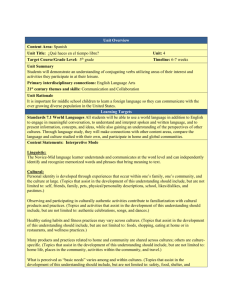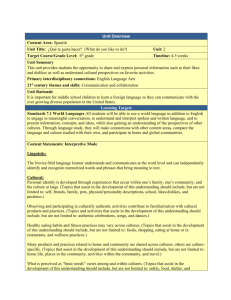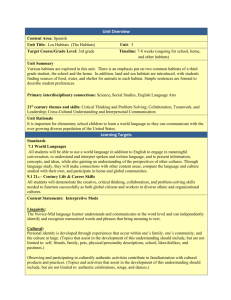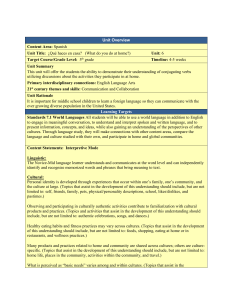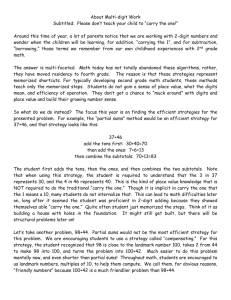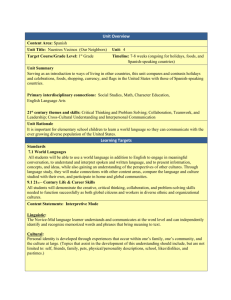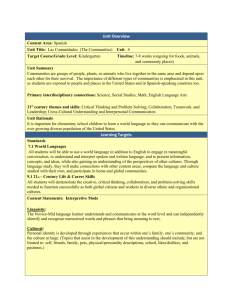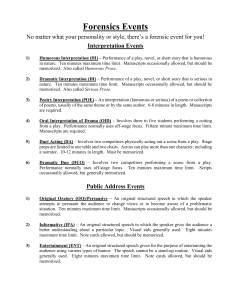Word - State of New Jersey
advertisement
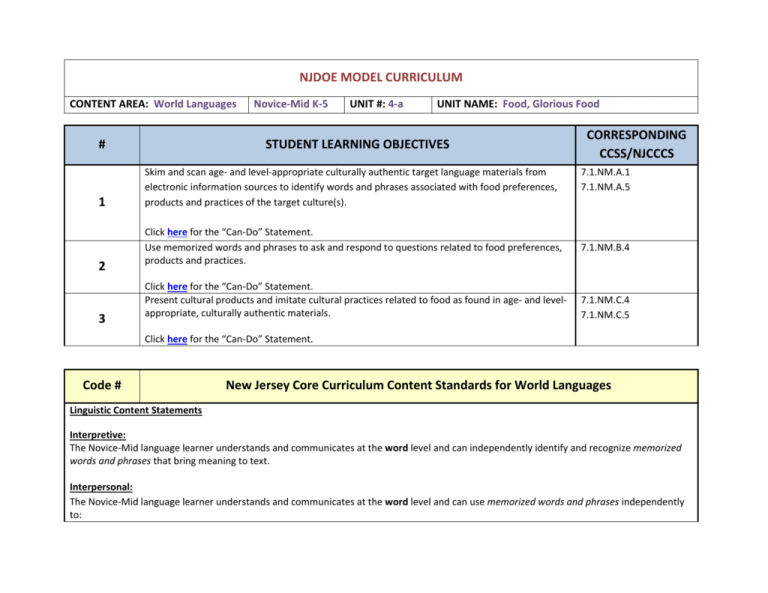
NJDOE MODEL CURRICULUM CONTENT AREA: World Languages # 1 2 3 Novice-Mid K-5 UNIT #: 4-a UNIT NAME: Food, Glorious Food STUDENT LEARNING OBJECTIVES Skim and scan age- and level-appropriate culturally authentic target language materials from electronic information sources to identify words and phrases associated with food preferences, products and practices of the target culture(s). Click here for the “Can-Do” Statement. Use memorized words and phrases to ask and respond to questions related to food preferences, products and practices. Click here for the “Can-Do” Statement. Present cultural products and imitate cultural practices related to food as found in age- and levelappropriate, culturally authentic materials. CORRESPONDING CCSS/NJCCCS 7.1.NM.A.1 7.1.NM.A.5 7.1.NM.B.4 7.1.NM.C.4 7.1.NM.C.5 Click here for the “Can-Do” Statement. Code # New Jersey Core Curriculum Content Standards for World Languages Linguistic Content Statements Interpretive: The Novice-Mid language learner understands and communicates at the word level and can independently identify and recognize memorized words and phrases that bring meaning to text. Interpersonal: The Novice-Mid language learner understands and communicates at the word level and can use memorized words and phrases independently to: NJDOE MODEL CURRICULUM CONTENT AREA: World Languages o o o o Novice-Mid K-5 UNIT #: 4-a UNIT NAME: Food, Glorious Food Respond to learned questions. Ask memorized questions. State needs and preferences. Describe people, places, and things. Presentational: The Novice-Mid language learner understands and communicates at the word level and can use memorized words and phrases independently to: o Make lists. o State needs and preferences. o Describe people, places, and things. Cultural Content Statement(s): Healthy eating habits and fitness practices may vary across cultures. (Topics that assist in the development of this understanding should include, but are not limited to: foods, shopping, eating at home or in restaurants, and wellness practices.) Many products and practices related to home and community are shared across cultures; others are culture-specific. (Topics that assist in the development of this understanding should include, but are not limited to: home life, places in the community, activities within the community, and travel.) 7.1.NM.A.1 Recognize familiar spoken or written words and phrases contained in culturally authentic materials using electronic information sources related to targeted themes. This CPI supports Anchor Standards 1 & 4 CCSS-ELA Reading. 7.1.NM.A.5 Demonstrate comprehension of brief oral and written messages using age- and level-appropriate, culturally authentic materials on familiar topics. This CPI supports Anchor Standard 6 CCSS-ELA Writing and Anchor Standard 1 CCSS-ELA Speaking & Listening. 7.1.NM.B.4 Ask and respond to simple questions, make requests, and express preferences using memorized words and phrases. This CPI supports Anchor Standard 1 CCSS-ELA ELA Speaking & Listening. 7.1.NM.C.4 Present information from age- and level-appropriate, culturally authentic materials orally or in writing. This CPI supports Anchor Standard 4 CCSS-ELA Writing and Anchor Standard 4 CCSS-ELA Speaking & Listening. NJDOE MODEL CURRICULUM CONTENT AREA: World Languages 7.1.NM.C.5 Novice-Mid K-5 UNIT #: 4-a UNIT NAME: Food, Glorious Food Name and label tangible cultural products and imitate cultural practices from the target culture(s). CONCEPTS WHAT DO STUDENTS NEED TO KNOW? Names of common vegetables, fruits, grains, proteins, and dairy items Colors Names of common ‘empty calorie’ foods Adjectives used to describe food (e.g. fresh, frozen, canned, and homemade) Adjectives to describe size and shape of food Memorized questions related to describing food The following items have already been assessed in previous units and are being recycled in this unit: The structures necessary to: o State a preference o Express likes and dislikes o Indicate location o Compare SKILLS WHAT DO STUDENTS NEED TO BE ABLE TO DO? Identify main idea of an authentic text dealing with food products and practices. Ask questions related to food preferences, products, and practices. Answer questions related to food preferences, products, and practices. Present information related to food preferences, products, and practices in the target culture based on information found in age- and level-appropriate, culturally authentic materials. UNIT DESCRIPTION Students use the target language in the three modes of communication to explore cultural products and practices related to foods in the home and target cultures. (Assessment of the interpretive mode may be in English; however, the text is always in the target language.) Interpretive: They interpret age- and level-appropriate authentic written and/or video/audio texts such as menus, supermarket advertisements, recipes, food blogs, and short video clips that focus on foods in the target culture. NJDOE MODEL CURRICULUM CONTENT AREA: World Languages Novice-Mid K-5 UNIT #: 4-a UNIT NAME: Food, Glorious Food Interpersonal: They engage in short unrehearsed/unscripted conversations with classmates, the teacher, and members of the target language community, in which they ask and answer questions and express preferences related to food preferences, products and practices. Presentational: They use lists, chunks of language, and memorized phrases to compare food preferences, products and practices in the home and target cultures. SLO # 1 CAN DO STATEMENTS ALIGNED TO THE SLOS In order to accommodate all types of K-5 programs, both Interpretive Listening and Interpretive Reading are included below; however, the sample assessments of the SLOs will only be provided for Interpretive Listening. Interpretive Listening: I can understand some basic information as found in short audio/video clips when someone describes what they like to eat and what is commonly eaten in their culture. I can understand some basic information as found in short audio/video clips when someone talks about a few practices associated with meal time, ordering a meal, and purchasing food. Interpretive Reading: I can understand some basic information found in short written texts about what people like to eat and what is commonly eaten in their culture. 2 I can understand some basic information found in short written texts about practices associated with meal time, ordering a meal, and purchasing food. Interpersonal: NJDOE MODEL CURRICULUM CONTENT AREA: World Languages Novice-Mid K-5 UNIT #: 4-a UNIT NAME: Food, Glorious Food I can ask memorized questions (yes/no, either/or, and short response) about food preferences. I can answer simple questions (yes/no, either/or, and short response) about food preferences. I can ask memorized questions (yes/no, either/or, and short response) to find out about foods that are typical in the target culture. I can answer simple questions (yes/no, either/or, and short response) about foods that are typical in my culture and the target culture. I can ask memorized questions (yes/no, either/or, and short response) about meal time in my culture and the target culture. 3 I can answer simple questions (yes/no, either/or, and short response) about meal time in my culture and the target culture. Presentational: Speaking and/or Writing – The focus for K-5 programs is on speaking in the presentational mode with limited emphasis on writing. As such, the sample assessments of the SLOs will be provided for speaking. I can use words, phrases, and memorized sentences to share information I learned about foods that are common in the target culture and a few practice associated with foods in the target culture. a. I can use a graphic organizer to categorize foods popular in the United States and the target culture. b. I can use a graphic organizer to compare food practices.
